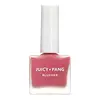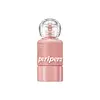What's inside
What's inside
 Key Ingredients
Key Ingredients

 Benefits
Benefits

 Concerns
Concerns

 Ingredients Side-by-side
Ingredients Side-by-side

Water
Skin ConditioningCyclopentasiloxane
EmollientAlcohol Denat.
AntimicrobialButylene Glycol
HumectantCetyl Ethylhexanoate
EmollientMethyl Trimethicone
Skin ConditioningTalc
AbrasiveGlycerin
HumectantPentylene Glycol
Skin ConditioningPEG-10 Dimethicone
Skin ConditioningTriethylhexanoin
MaskingSynthetic Fluorphlogopite
Methyl Methacrylate Crosspolymer
Polypropylsilsesquioxane
Trimethylsiloxysilicate
EmollientMagnesium Sulfate
Phenoxyethanol
PreservativeCetyl PEG/PPG-10/1 Dimethicone
EmulsifyingDisteardimonium Hectorite
StabilisingTitanium Dioxide
Cosmetic ColorantDimethicone
EmollientCI 73360
Cosmetic ColorantDimethicone Crosspolymer
Emulsion StabilisingParfum
MaskingUltramarines
Triethoxycaprylylsilane
Ethylhexylglycerin
Skin ConditioningDisodium EDTA
Iron Oxides
Prunus Avium Fruit Extract
Skin ConditioningRosa Damascena Flower Water
MaskingFicus Carica Fruit Extract
HumectantCitrus Aurantium Dulcis Peel Oil
MaskingSimmondsia Chinensis Seed Oil
EmollientCamellia Oleifera Seed Oil
Skin ConditioningNigella Sativa Seed Oil
EmollientPunica Granatum Seed Oil
EmollientRosa Canina Fruit Oil
EmollientVitis Vinifera Fruit Extract
Skin ConditioningPrunus Armeniaca Fruit Extract
Skin Conditioning1,2-Hexanediol
Skin ConditioningVaccinium Angustifolium Fruit Extract
Skin ProtectingFragaria Chiloensis Fruit Extract
Skin ConditioningPrunus Persica Fruit Extract
AbrasiveRubus Idaeus Fruit Extract
AstringentCaprylyl Glycol
EmollientOctanediol
Water, Cyclopentasiloxane, Alcohol Denat., Butylene Glycol, Cetyl Ethylhexanoate, Methyl Trimethicone, Talc, Glycerin, Pentylene Glycol, PEG-10 Dimethicone, Triethylhexanoin, Synthetic Fluorphlogopite, Methyl Methacrylate Crosspolymer, Polypropylsilsesquioxane, Trimethylsiloxysilicate, Magnesium Sulfate, Phenoxyethanol, Cetyl PEG/PPG-10/1 Dimethicone, Disteardimonium Hectorite, Titanium Dioxide, Dimethicone, CI 73360, Dimethicone Crosspolymer, Parfum, Ultramarines, Triethoxycaprylylsilane, Ethylhexylglycerin, Disodium EDTA, Iron Oxides, Prunus Avium Fruit Extract, Rosa Damascena Flower Water, Ficus Carica Fruit Extract, Citrus Aurantium Dulcis Peel Oil, Simmondsia Chinensis Seed Oil, Camellia Oleifera Seed Oil, Nigella Sativa Seed Oil, Punica Granatum Seed Oil, Rosa Canina Fruit Oil, Vitis Vinifera Fruit Extract, Prunus Armeniaca Fruit Extract, 1,2-Hexanediol, Vaccinium Angustifolium Fruit Extract, Fragaria Chiloensis Fruit Extract, Prunus Persica Fruit Extract, Rubus Idaeus Fruit Extract, Caprylyl Glycol, Octanediol
Hydrogenated Polyisobutene
EmollientHydrogenated Poly(C6-14 Olefin)
EmollientMica
Cosmetic ColorantDiisostearyl Malate
EmollientOctyldodecanol
EmollientTrimethylsiloxysilicate
EmollientIsododecane
EmollientHydrogenated Styrene/Isoprene Copolymer
Silica
AbrasiveTitanium Dioxide
Cosmetic ColorantSorbitan Isostearate
EmulsifyingSorbitan Sesquioleate
EmulsifyingDisteardimonium Hectorite
StabilisingPhenoxyethanol
PreservativeCI 77491
Cosmetic ColorantPropylene Carbonate
SolventCI 19140
Cosmetic ColorantCI 45410
Cosmetic ColorantCI 77499
Cosmetic ColorantCI 15985
Cosmetic ColorantTriethoxycaprylylsilane
Aluminum Hydroxide
EmollientParfum
MaskingPolyhydroxystearic Acid
EmulsifyingPentaerythrityl Tetra-Di-T-Butyl Hydroxyhydrocinnamate
AntioxidantTocopherol
AntioxidantHydrogenated Polyisobutene, Hydrogenated Poly(C6-14 Olefin), Mica, Diisostearyl Malate, Octyldodecanol, Trimethylsiloxysilicate, Isododecane, Hydrogenated Styrene/Isoprene Copolymer, Silica, Titanium Dioxide, Sorbitan Isostearate, Sorbitan Sesquioleate, Disteardimonium Hectorite, Phenoxyethanol, CI 77491, Propylene Carbonate, CI 19140, CI 45410, CI 77499, CI 15985, Triethoxycaprylylsilane, Aluminum Hydroxide, Parfum, Polyhydroxystearic Acid, Pentaerythrityl Tetra-Di-T-Butyl Hydroxyhydrocinnamate, Tocopherol
 Reviews
Reviews

Ingredients Explained
These ingredients are found in both products.
Ingredients higher up in an ingredient list are typically present in a larger amount.
Disteardimonium Hectorite comes from the clay mineral named hectorite. It is used to add thickness to a product.
It can also help stabilize a product by helping to disperse other ingredients.
Hectorite is a rare, white clay mineral.
Learn more about Disteardimonium HectoriteParfum is a catch-all term for an ingredient or more that is used to give a scent to products.
Also called "fragrance", this ingredient can be a blend of hundreds of chemicals or plant oils. This means every product with "fragrance" or "parfum" in the ingredients list is a different mixture.
For instance, Habanolide is a proprietary trade name for a specific aroma chemical. When used as a fragrance ingredient in cosmetics, most aroma chemicals fall under the broad labeling category of “FRAGRANCE” or “PARFUM” according to EU and US regulations.
The term 'parfum' or 'fragrance' is not regulated in many countries. In many cases, it is up to the brand to define this term.
For instance, many brands choose to label themselves as "fragrance-free" because they are not using synthetic fragrances. However, their products may still contain ingredients such as essential oils that are considered a fragrance by INCI standards.
One example is Calendula flower extract. Calendula is an essential oil that still imparts a scent or 'fragrance'.
Depending on the blend, the ingredients in the mixture can cause allergies and sensitivities on the skin. Some ingredients that are known EU allergens include linalool and citronellol.
Parfum can also be used to mask or cover an unpleasant scent.
The bottom line is: not all fragrances/parfum/ingredients are created equally. If you are worried about fragrances, we recommend taking a closer look at an ingredient. And of course, we always recommend speaking with a professional.
Learn more about ParfumPhenoxyethanol is a preservative that has germicide, antimicrobial, and aromatic properties. Studies show that phenoxyethanol can prevent microbial growth. By itself, it has a scent that is similar to that of a rose.
It's often used in formulations along with Caprylyl Glycol to preserve the shelf life of products.
Titanium dioxide is a mineral UV filter widely used in sunscreens and cosmetics.
It is one of only two UV filters officially classified as “mineral” by regulatory agencies, the other being zinc oxide.
Titanium dioxide provides broad-spectrum protection mostly in the UVB and UVAII range, with some protection in the UVAI range.
While its UVA protection isn’t as strong as zinc oxide’s, the difference is minor.
A common myth is that mineral UV filters reflect UV light. However, modern research shows titanium dioxide absorbs UV radiation like chemical filters (~95% absorption & 5% reflection).
Thanks to its non-irritating nature, titanium dioxide is suitable for sensitive, acne-prone, or redness-prone skin. It is unlikely to cause "eye sting" like other sunscreen ingredients.
A major drawback of this ingredient is its white cast and thick texture. This is why mineral sunscreens often leave a white cast and are less cosmetically elegant than chemical/hybrid sunscreens.
To improve white cast and spreadability, micronized or nano-sized titanium dioxide is often used.
There are ongoing concerns surrounding nano-titanium oxide's impact on marine ecosystems.
There is no conclusive evidence that any form of titanium oxide (or any other sunscreen ingredients) will cause harm to marine ecosystems or coral reefs. The science is still developing but many consumers are keeping a close eye on this issue.
Please note, many destinations have reef-safety sunscreen rules. For instance, the U.S. Virgin Islands advises all visitors to use non-nano mineral sunscreens.
Nano mineral sunscreens once raised safety concerns about absorption into skin.
Extensive research has shown that they do not penetrate healthy or damaged skin; they remain safely on the surface and the top layer of dead skin (stratum corneum).
You'll likely find titanium dioxide bundled with alumina, silica, or dimethicone. These ingredients help make titanium dioxide highly photostable; this prevents it from interacting with other formula components under UV light.
Learn more about Titanium DioxideTriethoxycaprylylsilane is a silicone used to bind and stabilize ingredients.
As an emulsifier, it helps prevent ingredients from separating. This can help elongate the shelf life of products.
Triethoxycaprylylsilane is often used to coat mineral sunscreens ingredients to help give a better feel. It also helps reduce oxidative stress in sunscreens.
Learn more about TriethoxycaprylylsilaneThis silicone is an emollient. Emollients create a thin film on the skin to prevent moisture from escaping.
It is not soluble in water and helps increase water-resistance in products.
According to a manufacturer, it can blend seamlessly with silicone oils, such as Cyclopentasiloxane.
Learn more about Trimethylsiloxysilicate